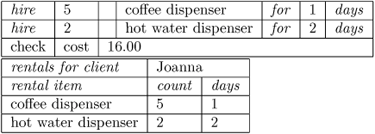Section 14.4. Which Client
14.4. Which Client"It's odd to have to mention the Client in every table," suggested Don. "In RentEz, a particular Client is selected and then any rentals, returns, and so on, are carried out within the context of that Client. This would be fine with one or two tests, but as we add more and more tests, there is much more incentive to be concise." So Don altered the tests again to make the Client implicit after being selected. He decided to use an action in an extra table to select the current Client. This is shown in the revised SetUp tables in Figure 14.6. Figure 14.6. Changed SetUp to Select the Client The other tests were then altered to not mention the current Client, as shown in Figures 14.7 and 14.8. To be clear that only the Rentals shown in the last table of each test are for the specified Client (Joanna), Don changed that table to rentals for client. Figure 14.7. Changed Rental Test Figure 14.8. Changed Partial Return Test He also changed the wording of the rentals and returns in the tables to read more easily; it's fine to have empty keywords. The vocabulary we use often changes like this as part of the ongoing dialogue and invention of a good way of expressing tests. The group had other work to attend to, so we agreed to continue with these tests the next day. Questions & Answers
Tip We're really eager to avoid unnecessary repetition in tests generally, not just in the SetUp. As the number of tests grows, the redundancy makes it
|
EAN: 2147483647
Pages: 331


